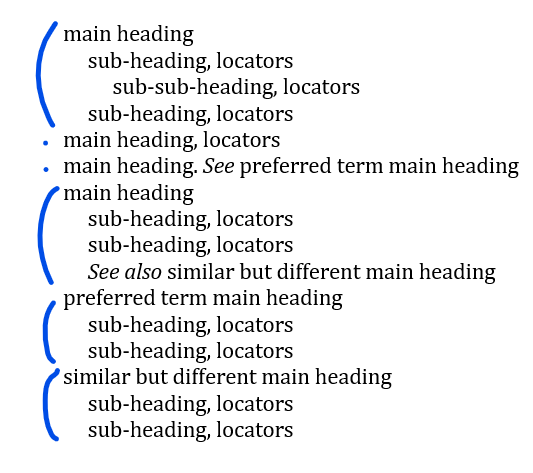Anatomy of an Index
Indexes Are Composed of Entries
An index entry is made up of headings: main headings are the backbone forming the structure of the index. Sub-headings branch off of those main headings to provide detail or granularity to each main heading topic. They should be used when a heading has more than five or six locators following it. Cross references link similar but different concepts to help readers identify all relevant information. Locators (or locator strings) are the page numbers following a heading; they indicate where in the text a term or concept may be found.
Qualifiers and modifiers are words that are used to resolve issues of ambiguity. Modifiers typically follow a comma. (When there is more than one modifier for a heading, they may be turned into sub-headings.)
unions, history of
…and qualifiers are almost always enclosed in parentheses. They usually distinguish homonyms or synonyms:
NASA (National Aeronautics and Space Administration)
NASA (National Auto Sport Association)
Georgia (country)
Georgia (US state)
Both qualifiers and modifiers may be used in the same entry:
Georgia (country), history of
Punctuation
Colons are typically used in run-in style indexes to separate a main heading with no locators from its sub-headings.
example: first sub-heading, 42, 44; second sub-heading, 47-49
Commas followed by a space are most often used to separate locators (page numbers) in a string, and in a heading, they indicate modifiers.
unions, history of, 42, 44, 47-49
Periods usually only appear when there is a cross reference from a main heading. (When they do appear in a sub-heading, cross-references are usually see references and are enclosed in parentheses.)
example, non-preferred term. See preferred term
Semicolons are typically used to separate multiple terms in a cross reference or, in a run-in index, to separate sub-headings.
aircraft. See fixed-wing aircraft; rotary-wing aircraft
fixed-wing aircaft: characteristics, 42-45; history of, 40-42
Index Formats
Indented format is common among publishers and allows for easy browsing of the index. Run-in format is used, often in trade publications, to save space.
The two images below demonstrate the components of an index. In the examples below, each entry is marked with blue lines for multi-line entries, or dots for those short enough to fit on one line.
Indented Format
Run-in Format
Sub-sub-headings should be avoided in Run-in style indexes, however CMS section 16.27 discusses some options for indexers.
All rules cited here follow the recommendations of Chicago Manual of Style (CMS), 17th ed. Publishers may provide house-specific style guides, which should be followed accordingly.

